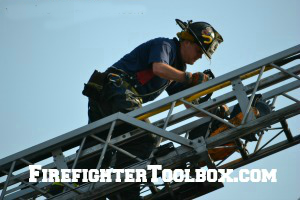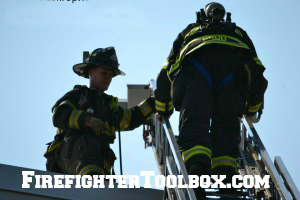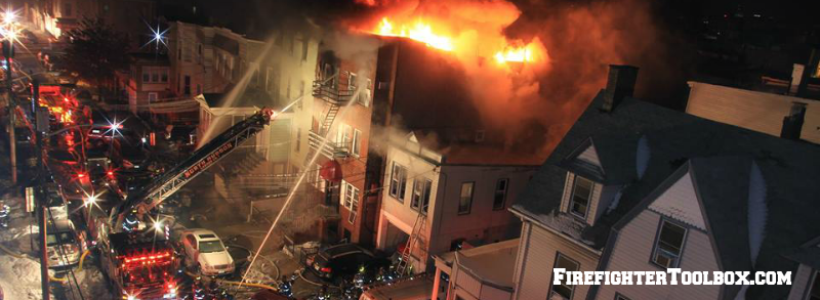3 Ways To Access The Roof Quickly – Part 2
In my previous article of this series, we discussed using adjoining buildings to get to the roof. Now we will concentrate on the next best way to get to the roof — ladders.
#2 – Ladders
Ladders, either ground or aerial, are the second best way to access the roof. The use of aerial ladders, either a platform or a straight stick laddered to the roof usually will get you topside with your tools quicker than throwing an extension ladder to the roof.
There are a few key items that need to be looked for when placing ladders to the roof.
Watch For Overhead Obstructions
Overhead obstructions — most importantly power lines but phone and cables lines as well — must be avoided at all costs. Contact with these lines will, at the least, cause you issues. The most severe issue is electrocution.
Power lines have been known to arc and electricity follows the path of least resistance to the ground. Contact with wires by an aerial ladder or ground ladder will at least cause damage or injury and the worst case scenario is death of a firefighter or crew.
Avoid The Flames
Place the ladder so it will not come into contact with fire venting from the building, especially if your task is to operate on the roof. Flame impingement on a ladder will weaken the ladder and potentially cause it to fail when a load is placed on it.
 Climb Safely
Climb Safely
When climbing any ladder, remember to always maintain 3 points of contact at all times. This safety practice is essential to maintaining proper balance and control. When carrying tools to the roof it is imperative to be conscious of any potential shift of weight by a tool so that you can be prepared for it and not lose your balance.
 Access The Roof Carefully
Access The Roof Carefully
Set the ladder so the rungs extend 3 to 5 feet above the wall so it makes it easier to get on and off the ladder. While on the roof, the extended rungs above the roof line provides a good reference point when operating.
Before exiting onto the roof, do a visual size-up and be sure to sound the roof. Sounding the roof gives you an indication if the roof is sturdy enough to operate on.
Never jump onto the roof from the ladder. Jumping onto the roof from the ladder or platform will create a localized impact load in the place you land. If the roof was weak, you might compromise that area and the rest of the roof. Almost nothing is scarier than hearing that a firefighter has fallen through the roof into the burning building. Be proactive and keep yourself and your crew safe.
Be Weather-Wise
When there is inclement weather always take extra caution when climbing on and off the ladder to the roof. If there is ice and snow, perform a risk/benefit analysis before setting foot on a roof top skating rink. The first step onto an icy roof may be your last.
Ladders both aerial and ground are great tools to get on the roof. Use of caution with both types of ladders is essential.
Stay safe!
Photos courtesy of James Wood, Sr. and Brett Dzadik
Check out the complete series here!
3 Ways To Access The Roof Quickly
Part 1: Adjoining Buildings
Part 2: Ladders
Part 3: Fire Escapes (posting 9/1)





